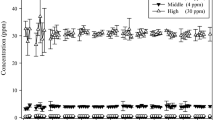Abstract
The pharmacokinetics of inhaled n-hexane in rat and man were compared. In the rat metabolism was saturable. Up to 300 ppm, the metabolic rate was directly proportional to the concentration in the atmosphere, reaching 47 μmol/(h· kg). Only 17% of n-hexane was exhaled unchanged. Above 300 ppm, the amount of n-hexane in the body rose with increasing atmospheric concentrations from 1.6 up to a limiting value of 9.6, which corresponded to the thermodynamic distribution coefficient of n-hexane between the organism and the atmosphere. Up to 3000 ppm, the rate of metabolism increased to 245 μmol/ (h· kg); only a slow further increase was found up to 7000 ppm (285μmol/(h· kg)).
In man the steady-state concentrations of n-hexane were about 1 ppm. The metabolic clearance was 1321/h, and n-hexane accumulated to a factor of 2.3 in the organism. The thermodynamic distribution coefficient was calculated to be 12. Twenty per cent of n-hexane in the body was exhaled unchanged.
At low concentrations the rate of metabolism of n-hexane is limited in both species by transport to the enzyme system. Under these conditions the rate of metabolism of n-hexane should not be influenced by xenobiotics which induce the n-hexane metabolizing enzyme system.
Similar content being viewed by others
References
Anthony DC, Boekelheide K, Anderson CW, Graham DG (1983) The effect of 3,4-dimethyl substitution on the neurotoxicity of 2,5-hexanedione. II. Dimethyl substitution accelerates pyrrole formation and protein crosslinking. Toxicol Appl Pharmacol 71:372–382
Bolt HM, Filser JG, Buchter A (1981) Inhalation pharmacokinetics based on gas uptake studies. III. A pharmacokinetic assessment in man of “peak concentrations” of vinyl chloride. Arch Toxicol 48: 213–228
Boxenbaum H (1980) Interspecies variation in liver weight, hepatic blood flow, and antipyrine intrinsic clearance: Extrapolation of data to benzodiazepines and phenytoin. J Pharmacokinet Biopharm 8: 165–176
Buchter A, Bolt HM, Filser JG, Goergens HW, Laib RJ, Bolt W (1978) Pharmakokinetik und Karzinogenese von Vinylchlorid. Arbeitsmedizinische Risikobeurteilung. Verh Dtsch Ges Arbeitsmedizin (Gentner Verlag, Stuttgart) 18: 111–124
Buchter A (1979) Erarbeitung einer speziellen arbeitsmedizinischen Überwachungsuntersuchung in Korrelation zur individuellen Vinylchlorid-Exposition. Forschungsbericht des Landes Nordrhein-Westfalen, Fachgruppe Medizin, Nr. 2813, Westdeutscher Verlag, Opladen
Couri D, Milks M (1982) Toxicity and metabolism of the neurotoxic hexacarbons n-hexane, 2-hexanone, and 2,5-hexanedione. Ann Rev Pharmacol Toxicol 22: 145–166
DeCaprio AP, Strominger NL, Weber P (1983) Neurotoxicity and protein binding of 2,5-hexanedione in the hen. Toxicol Appl Pharmacol 68: 297–307
DGMK (1982) Evaluation of n-hexane toxicity in man and animals. Deutsche Gesellschaft für Mineralölwissenschaft und Kohlechemie e. V., DGMK-Project 174-2
Filser JG, Bolt HM (1981) Inhalation pharmacokinetics based on gas uptake studies. I. Improvement of kinetic models. Arch Toxicol 47: 279–292
Filser JG, Bolt HM (1983) Inhalation pharmacokinetics based on gas uptake studies. IV. The endogenous production of volatile compounds. Arch Toxicol 52: 123–133
Filser JG, Bolt HM, Muliawan H, Kappus H (1983) Quantitative evaluation of ethane and n-pentane as indicators of lipid peroxidation in vivo. Arch Toxicol 52: 135–147
Nomiyama K, Nomiyama H (1974) Respiratory retention, uptake and excretion of organic solvents in man. Int Arch Arbeitsmed 32: 75–83
Römmelt H, Dirnagl K (1977) Pulmonale Resorption von sechs Kohlenwasserstoffen in Abhängigkeit von der Konzentration in der Atemluft. Münch Med Wschr 119: 367–368
Perbellini L, Brugnone F, Pavan I (1980) Identification of the metabolites of n-hexane, cyclohexane, and their isomeres in men's urine. Toxicol Appl Pharmacol 53: 220–229
Schütz E, Caspers H, Speckmann E-J (1978) Physiologie. 15. Aufl., Urban & Schwarzenberg, München-Wien-Baltimore
Siegers C-P, Filser JG, Bolt HM (1978) Effect of dithiocarb on metabolism and covalent binding of carbon tetrachloride. Toxicol Appl Pharmacol 46: 709–716
Spencer PS, Schaumburg HH (1977) Ultrastructural studies of the dying-back process. IV. Differential vulnerability of PNS and CNS fibers in experimental central peripheral distal axonopathies. J Neuropathol Exp Neurol 36: 300–320
Author information
Authors and Affiliations
Additional information
Dedicated to Professor Dr. med. Herbert Remmer on the occasion of his 65th birthday
Rights and permissions
About this article
Cite this article
Filser, J.G., Peter, H., Bolt, H.M. et al. Pharmacokinetics of the neurotoxin n-hexane in rat and man. Arch Toxicol 60, 77–80 (1987). https://doi.org/10.1007/BF00296952
Issue Date:
DOI: https://doi.org/10.1007/BF00296952




